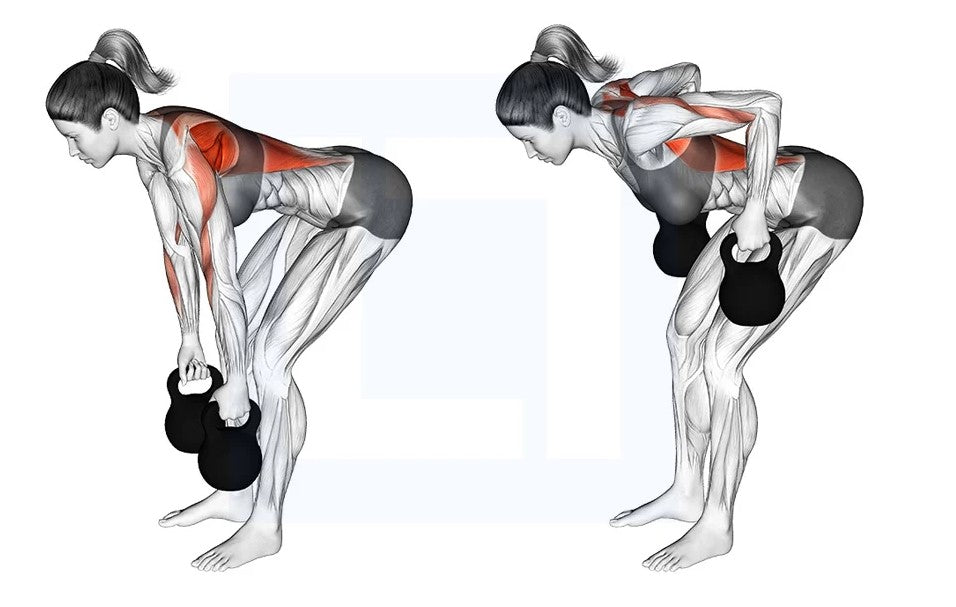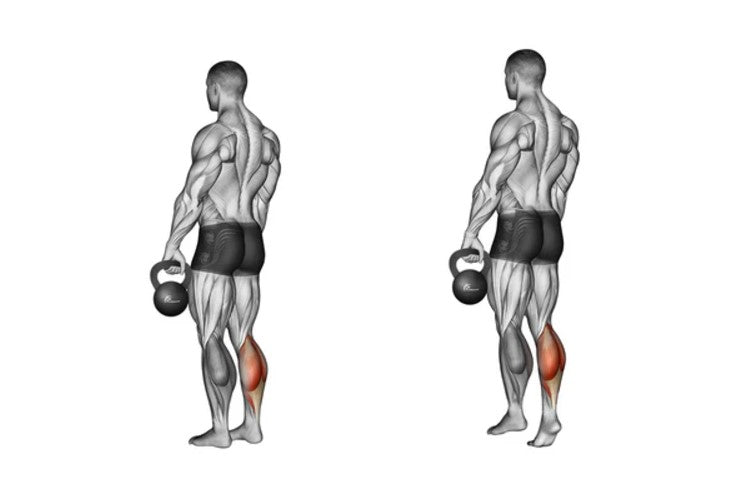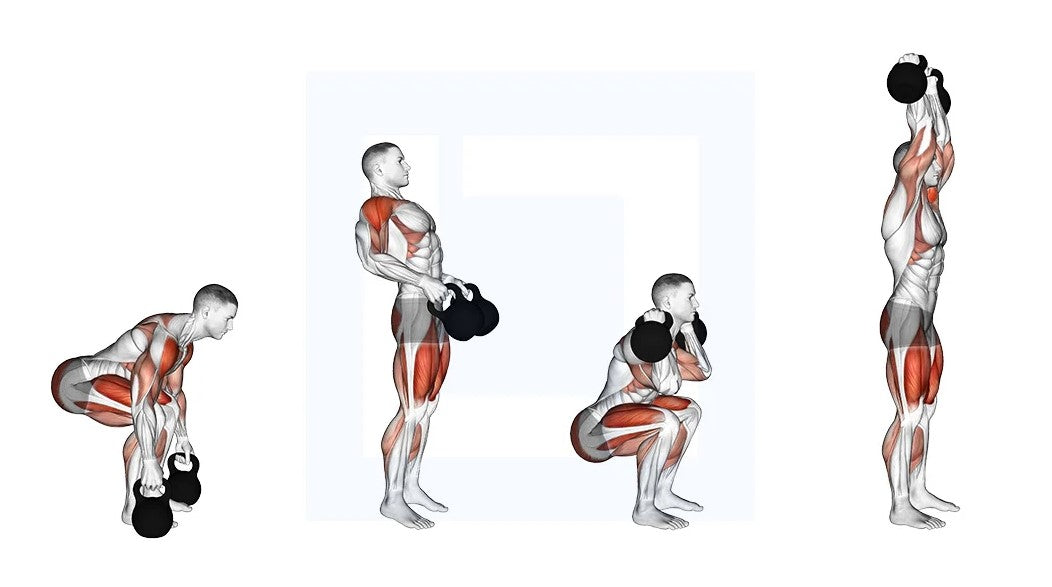The kettlebell bent-over row is a powerful exercise to help you build a strong, defined back and improve overall upper body stability. Unlike standard rows, the kettlebell variation uniquely targets muscles throughout your back and core, while requiring you to stabilize through your forearms and grip. This guide covers everything from the anatomy involved to form, common mistakes, benefits, and tips for incorporating this essential move into your routine. With kettlebell bent-over rows, you’re on your way to explosive strength and improved posture.
What Muscles Does the Kettlebell Bent-Over Row Target?
The kettlebell bent-over row is a compound exercise that primarily targets the upper back, though it also engages secondary muscle groups, making it a well-rounded movement for balanced strength development.
Primary Muscles Worked
-
Latissimus Dorsi (Lats): The lats, the largest muscles in the back, play a crucial role in creating the pulling motion required for the bent-over row. This movement helps develop the width and thickness of the back, enhancing strength and posture.
-
Rhomboids: Located between the shoulder blades, the rhomboids retract the scapula, aiding in back stability. Strengthening these muscles with rows helps prevent shoulder injuries and encourages an upright posture.
- Trapezius (Traps): The traps stabilize the shoulder blades and upper back, supporting the spine and enabling you to control heavier weights.
Secondary Muscles Engaged
-
Biceps: While primarily an upper-back exercise, the bent-over row engages the biceps for the pulling movement, providing secondary arm strength development.
-
Forearms and Grip Strength: Holding and lifting the kettlebell strengthens your grip and forearm muscles, which is beneficial for other exercises like deadlifts and carries.
- Core Muscles: Maintaining a bent-over position requires engagement of the core, enhancing stability and balance while working the deeper muscles around the spine.
By strengthening these muscle groups, the kettlebell bent-over row improves overall upper body function, posture, and performance in other lifts and activities.
How the Kettlebell Bent-Over Row Compares to Other Back Exercises
The kettlebell bent-over row offers unique benefits compared to other back exercises, such as barbell rows, pull-ups, and lat pulldowns.
1. Barbell Row
https://www.youtube.com/watch?v=kBWAon7ItDw
The barbell row is a powerful back exercise but can place added stress on the lower back. The kettlebell row allows for a more controlled, unilateral movement (one side at a time) and places less strain on the lumbar region, making it a safer alternative for those with lower back concerns.
2. Dumbbell Row
https://www.youtube.com/watch?v=DMo3HJoawrU
Like the kettlebell row, the dumbbell row is also a unilateral exercise. However, kettlebells require greater stabilization due to their unique shape and center of gravity, activating the stabilizing muscles in the forearms and core to a greater extent.
3. Lat Pulldown and Pull-Ups
https://www.youtube.com/shorts/rjgHTqJxjn0
Both exercises focus primarily on the lat muscles, while the kettlebell bent-over row targets a wider range of back and upper-body muscles. For a comprehensive back workout, combining rows with pulldowns or pull-ups is highly effective.
Overall, the kettlebell bent-over row is unique for its stabilizing demands and accessibility, making it an excellent addition to a balanced back workout routine.
How Do I Perform a Proper Kettlebell Bent-Over Row?
Performing the kettlebell bent-over row with proper form is essential for maximizing its benefits and avoiding injury. Here’s a step-by-step guide to mastering the movement.
Step-by-Step Guide to Mastering the Form
https://www.youtube.com/watch?v=mEN-azCAwnE
-
Set Up the Position:
- Stand with feet hip-width apart, holding a kettlebell in each hand or one hand if you’re performing a single-arm row.
- Hinge at the hips, keeping a slight bend in the knees. Keep your back straight and your torso at a 45-degree angle to the ground.
-
Engage the Core:
- Brace your core by pulling your belly button toward your spine. This stabilizes the lower back and prevents rounding.
-
Grip the Kettlebell Firmly:
- Ensure a firm grip on the kettlebell and maintain a neutral wrist position to avoid unnecessary strain on the wrist and forearm.
-
Execute the Row:
- Drive your elbow up toward the ceiling, keeping it close to your body. The kettlebell should move in a straight line along your torso.
- Focus on squeezing the shoulder blades together at the top of the movement.
-
Lower with Control:
- Lower the kettlebell slowly and return to the starting position, allowing your arm to fully extend.
-
Repeat:
- Aim for controlled, smooth repetitions rather than rushing through the set.
Common Mistakes to Avoid
-
Rounding the Back: A rounded back can place unnecessary strain on the spine, increasing the risk of injury. Maintain a flat back by keeping your core engaged and hinging from the hips.
-
Using Momentum: Swinging the kettlebell with momentum reduces the work of the back muscles and increases the chance of injury. Focus on controlled movements to keep tension on the target muscles.
- Not Retracting Shoulder Blades: Failing to squeeze the shoulder blades together limits the exercise’s effectiveness. Engage your upper back by retracting the shoulder blades at the top of each row.
Tips for Maintaining Proper Posture and Alignment
- Feet Position: Keep feet firmly planted and slightly bend your knees for stability.
- Core Engagement: Engage your core throughout the exercise to maintain balance and protect your spine.
- Head Position: Keep your neck in line with your spine, avoiding craning or lowering your head.
What Are the Benefits of Incorporating Kettlebell Bent-Over Rows into My Workout Routine?
The kettlebell bent-over row offers multiple benefits that extend beyond back development, making it a valuable addition to any workout plan.
Improved Back Strength and Muscle Development
By targeting multiple back muscles, including the lats, rhomboids, and traps, the kettlebell row develops a well-rounded and strong upper back. This helps improve posture and performance in other exercises, such as deadlifts and squats.
Enhanced Grip Strength and Forearm Endurance
Holding and rowing the kettlebell strengthens the grip, which is essential for other heavy lifts and practical tasks outside the gym. Stronger forearms also help reduce strain on the wrists during pulling exercises.
Increased Core Stability and Functional Fitness
Maintaining the bent-over position requires core engagement and balance, leading to increased stability. This functional strength benefits everyday activities and helps prevent lower back injuries.
Are There Any Variations of the Kettlebell Bent-Over Row I Should Try?
Adding variations to the kettlebell row not only prevents workout monotony but also allows you to target different muscle groups and training goals.
Single-Arm Kettlebell Bent-Over Row
https://www.youtube.com/watch?v=9Q9gwoXHn1o
Performing the row with one arm at a time enhances unilateral strength and corrects muscle imbalances. It also challenges the core further, as the body must stabilize against the asymmetrical load.
Double Kettlebell Bent-Over Row
https://www.youtube.com/watch?v=Db2NSEyPY_Y
Using two kettlebells increases the intensity and load on the back muscles. This variation is ideal for those looking to build significant back strength and mass.
Renegade Row
https://www.youtube.com/watch?v=Q28cLuweLv4
The renegade row involves holding a plank position while performing the row, which greatly engages the core and stabilizing muscles. It’s an advanced variation that enhances both core and back strength.
How Can I Integrate Kettlebell Bent-Over Rows into My Existing Workout Plan?
The kettlebell bent-over row can be incorporated into your back workouts, upper body days, or full-body routines, depending on your fitness goals.
Sample Back Workout Routine Featuring Kettlebell Bent-Over Rows
- Warm-Up: 5-10 minutes of light cardio and dynamic stretching.
- Kettlebell Bent-Over Row: 3 sets of 10-12 reps
- Pull-Ups or Lat Pulldowns: 3 sets of 8-10 reps
- Seated Cable Row: 3 sets of 10 reps
- Renegade Row: 3 sets of 8-10 reps (per side)
Recommended Sets, Reps, and Rest Periods for Optimal Results
- Beginners: 2-3 sets of 10-12 reps with 45-60 seconds of rest between sets.
- Intermediate to Advanced: 3-4 sets of 8-10 reps with 60-90 seconds of rest for hypertrophy or 4-6 reps with 2 minutes of rest for strength.
What Are Some Common Mistakes to Avoid When Performing Kettlebell Bent-Over Rows?
Avoiding common mistakes ensures you gain the maximum benefits from your rows while staying safe and injury-free.
Rounding the Back and Compromising Form
Maintaining a flat back is crucial for avoiding lower back strain. Always engage your core and keep a neutral spine throughout the movement.
Using Momentum Instead of Controlled Movements
Swinging the kettlebell reduces the exercise’s effectiveness and increases injury risk. Aim for a controlled and deliberate motion, focusing on muscle contraction.
Neglecting Proper Breathing Techniques
Breathing can improve focus and core engagement. Exhale as you lift the kettlebell and inhale as you lower it, maintaining a steady rhythm.
Conclusion
The kettlebell bent-over row is an exceptional exercise that builds back strength, stability, and functional fitness. By targeting the lats, rhomboids, traps, and core, this exercise contributes to a balanced upper body and enhances grip and forearm endurance. With variations like the single-arm row and renegade row, you can challenge your muscles and keep your workouts fresh. Integrate kettlebell rows into your weekly routine to unleash your full back strength potential. Embrace proper form, avoid common mistakes, and enjoy the explosive results of consistent training with the kettlebell bent-over row.










